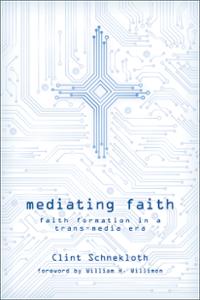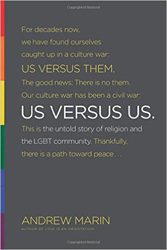 With just a few clicks, I can access hundreds of spiritual options. In fact, that’s just what I did earlier today as I was doing research for a new book. This amazing accessibility is a great challenge as well as opportunity for churches today. While once churches were located at the center of town and were the hub of peoples’ lives, now they are at the periphery and must contend not only with peoples’ active schedules but also the realities of internet pluralism. Christianity has moved, or been displaced, from the center to the margins of twenty-first century culture. This can be devastating. But, is it possible for the margins to become the frontiers, a growing edge reflecting our own lively resurrection culture? Theologian Clint Schnekloth and author of the new book, Mediating Faith, and I would answer “yes,” but in slightly different ways.
With just a few clicks, I can access hundreds of spiritual options. In fact, that’s just what I did earlier today as I was doing research for a new book. This amazing accessibility is a great challenge as well as opportunity for churches today. While once churches were located at the center of town and were the hub of peoples’ lives, now they are at the periphery and must contend not only with peoples’ active schedules but also the realities of internet pluralism. Christianity has moved, or been displaced, from the center to the margins of twenty-first century culture. This can be devastating. But, is it possible for the margins to become the frontiers, a growing edge reflecting our own lively resurrection culture? Theologian Clint Schnekloth and author of the new book, Mediating Faith, and I would answer “yes,” but in slightly different ways.
The philosopher Alfred North Whitehead once asserted that higher organisms initiate novelty to match the novelty of the environment. The Protestant Reformation emerged by responding creatively to the invention of the printing press. The Social Gospel movement shaped the 20th century by its novel responses to industrialization and the gap between the rich and the poor. Although most churches have neither the wherewithal nor desire to compete with the rapidly evolving digital realm, they still have something to offer the larger community. They still can respond to the needs of their congregants as well as seekers by a dynamic and forward-looking blend of order and novelty. The church does not need to mirror the cluttered digital world that surrounds us; but, it does need to present alternatives that address virtual realities and digital pluralism. The church needs to be both in and of the emerging transmedia technologies, while presenting its own ancient-future-now vision.
I speak as a congregational pastor whose church is embarking on creating a new website. Our current website has good content but is out of date in terms of capability and presentation. We are a mid-sized congregation with modest financial resources and just a few technologically-literate people who can help us create a dynamic interactive site. We need a new look; we also need content to respond to the spiritual quests of baby boomers, families, millennials, seekers, and the spiritual but not religious community on Cape Cod. We have a Facebook page and spread good news through that medium. We send out email blasts to the congregation. We depend on the generosity of the local print media to share our programs with the larger community. We realize that we are behind the curve technologically speaking; we also realize that we need to work out of our strengths.
Our greatest strengths involve worship, community, and spiritual offerings. Our worship is low tech but high quality and global in perspective. Our community welcomes strangers and is inclusive in spirit. Our spiritual offerings are aimed at nurturing seekers, spiritual but not religious persons, and our own members. We have been successful in attracting a growing number of recently-retired baby boomers, but have made virtually no dent in reaching out to persons under forty and young singles. Some of this is environmental (our Cape Cod village is mostly populated by boomers and their parents), some of it is technological. Our quest has been to balance order and tradition with novelty and innovation. We are still on the road, trying to find our way in the world of digital pluralism.
Ironically, one of our most successful media outreach has been the simplest – yard signs placed along our Main Street sidewalk and the parking lot we share with the library. People come to church and programs as a result of these low-tech forms of outreach. Of course, program is essential – the most popular off-the-street visitors have come to our Wednesday afternoon and evening “Still Point for Meditation.” These hour-long spiritual oases focus on silence, breath prayer, a short reflection, and the ancient practice of lectio divina. In a rapidly changing world, we need “still points” to retreat and find stillness and healing.
We are still exploring ways to market these programs to younger persons rather just baby boomers but we are making a first step. As John Naisbitt, author of Megatrends asserts, we are seeking to join high touch with high tech.
We have a long way to go. Our content and message are superb: next month we begin a bi-weekly series on spirituality, health, and healing. We anticipate a good community response as we explore the healings of Jesus in the 21st century, Christianity and reiki healing touch, spirituality for parents, spiritual practices for caregivers, and creative aging. We are not daunted by digital pluralism or the emerging virtual realities: we offer the flesh and blood incarnation of Christ’s presence and opportunities to turn off the technology and center down. We are committed to finding forms of media, appropriate to our congregation’s resources and spirit, and are open to any and all possibilities as we seek to initiate our own spiritual novelty in a trans-media era.
Read an excerpt from Mediating Faith – and watch a video Q&A with author Clint Schnekloth – at the Patheos Book Club here.













